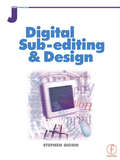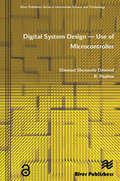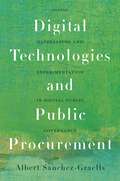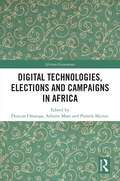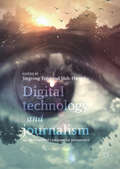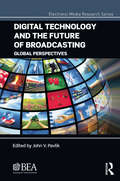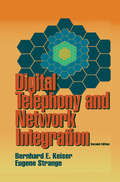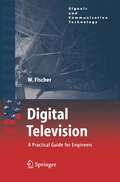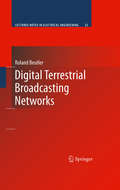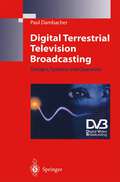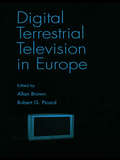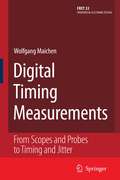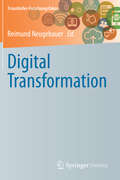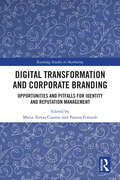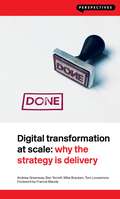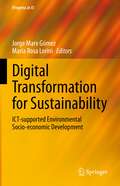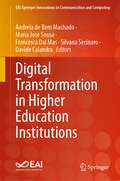- Table View
- List View
Digital Sub-Editing and Design
by Stephen QuinnThis excellent book covers editing in the digital age, demonstrating the tools needed for effective text editing. Learn how to write powerful headlines and captions, and how to edit body text quickly and cleanly. It also concentrates on design in the digital environment, introducing typography and the related issues of readability and legibility. The skills of picture editing are explored, including image selection, cropping, manipulation and the ethics involved. These core skills and methods are then applied to the World Wide Web. Recent research into how people navigate Web pages is considered, and recommends ways to write more effectively for the online medium. The first section concentrates on editing in the digital age, demonstrating the tools needed for effective text editing. Dr Quinn shows how to write powerful headlines and captions, and how to edit body text quickly and cleanly. The middle section concentrates on design in the digital environment. Chapter five introduces typography and the related issues of readability and legibility. Chapter six covers the principles of design and how they can be applied to print and electronic publications. Chapter seven looks at the skills of picture editing, including image selection, cropping, manipulation and the ethics involved. Chapter eight investigates other forms of visual presentation such as diagrams, logos, maps and cartoons. In the final section, these core skills and methods are applied to the World Wide Web. Chapter nine considers recent research into how people navigate Web pages, and recommends ways to write more effectively for the online medium. Chapter ten examines how the principles of print design can (and cannot) be applied to Web pages.
Digital Synthesizers and Transmitters for Software Radio
by Jouko VankkaThe approach adopted in Digital Synthesizers and Transmitters for Software Radio will provide an understanding of key areas in the field of digital synthesizers and transmitters. It is easy to include different digital techniques in the digital synthesizers and transmitters by using digital signal processing methods, because the signal is in digital form. By programming the digital synthesizers and transmitters, adaptive channel bandwidths, modulation formats, frequency hopping and data rates are easily achieved. Techniques such as digital predistortion for power amplifier linearization, digital compensation methods for analog I/Q modulator nonlinearities and digital power control and ramping are presented in this book. The flexibility of the digital synthesizers and transmitters makes them ideal as signal generators for software radio. Software radios represent a major change in the design paradigm for radios in which a large portion of the functionality is implemented through programmable signal processing devices, giving the radio the ability to change its operating parameters to accommodate new features and capabilities. A software radio approach reduces the content of radio frequency (RF) and other analog components of traditional radios and emphasizes digital signal processing to enhance overall transmitter flexibility. Software radios are emerging in commercial and military infrastructure.
Digital System Design - Use of Microcontroller
by Shenouda Dawoud R. PeplowEmbedded systems are today, widely deployed in just about every piece of machinery from toasters to spacecraft. Embedded system designers face many challenges. They are asked to produce increasingly complex systems using the latest technologies, but these technologies are changing faster than ever. They are asked to produce better quality designs with a shorter time-to-market. They are asked to implement increasingly complex functionality but more importantly to satisfy numerous other constraints. To achieve the current goals of design, the designer must be aware with such design constraints and more importantly, the factors that have a direct effect on them.One of the challenges facing embedded system designers is the selection of the optimum processor for the application in hand; single-purpose, general-purpose or application specific. Microcontrollers are one member of the family of the application specific processors.The book concentrates on the use of microcontroller as the embedded system?s processor, and how to use it in many embedded system applications. The book covers both the hardware and software aspects needed to design using microcontroller.The book is ideal for undergraduate students and also the engineers that are working in the field of digital system design.Contents• Preface;• Process design metrics;• A systems approach to digital system design;• Introduction to microcontrollers and microprocessors;• Instructions and Instruction sets;• Machine language and assembly language;• System memory; Timers, counters and watchdog timer;• Interfacing to local devices / peripherals;• Analogue data and the analogue I/O subsystem;• Multiprocessor communications;• Serial Communications and Network-based interfaces.
Digital System Design - Use of Microcontroller
by Shenouda Dawoud R. PeplowEmbedded systems are today, widely deployed in just about every piece of machinery from toasters to spacecraft. Embedded system designers face many challenges. They are asked to produce increasingly complex systems using the latest technologies, but these technologies are changing faster than ever. They are asked to produce better quality designs with a shorter time-to-market. They are asked to implement increasingly complex functionality but more importantly to satisfy numerous other constraints. To achieve the current goals of design, the designer must be aware with such design constraints and more importantly, the factors that have a direct effect on them.One of the challenges facing embedded system designers is the selection of the optimum processor for the application in hand; single-purpose, general-purpose or application specific. Microcontrollers are one member of the family of the application specific processors.The book concentrates on the use of microcontroller as the embedded system?s processor, and how to use it in many embedded system applications. The book covers both the hardware and software aspects needed to design using microcontroller.The book is ideal for undergraduate students and also the engineers that are working in the field of digital system design.Contents• Preface;• Process design metrics;• A systems approach to digital system design;• Introduction to microcontrollers and microprocessors;• Instructions and Instruction sets;• Machine language and assembly language;• System memory; Timers, counters and watchdog timer;• Interfacing to local devices / peripherals;• Analogue data and the analogue I/O subsystem;• Multiprocessor communications;• Serial Communications and Network-based interfaces.
Digital Technologies and Public Procurement: Gatekeeping and Experimentation in Digital Public Governance
by Albert Sanchez-GraellsThe digital transformation of the public sector has accelerated. States are experimenting with technology, seeking more streamlined and efficient digital government and public services. However, there are significant concerns about the risks and harms to individual and collective rights under new modes of digital public governance. Several jurisdictions are attempting to regulate digital technologies, especially artificial intelligence, however regulatory effort primarily concentrates on technology use by companies, not by governments. The regulatory gap underpinning public sector digitalisation is growing. As it controls the acquisition of digital technologies, public procurement has emerged as a 'regulatory fix' to govern public sector digitalisation. It seeks to ensure through its contracts that public sector digitalisation is trustworthy, ethical, responsible, transparent, fair, and (cyber) safe. However, in Digital Technologies and Public Procurement: Gatekeeping and Experimentation in Digital Public Governance, Albert Sanchez-Graells argues that procurement cannot perform this gatekeeping role effectively. Through a detailed case study of procurement digitalisation as a site of unregulated technological experimentation, he demonstrates that relying on 'regulation by contract' creates a false sense of security in governing the transition towards digital public governance. This leaves the public sector exposed to the 'policy irresistibility' that surrounds hyped digital technologies. Bringing together insights from political economy, public policy, science, technology, and legal scholarship, this thought-provoking book proposes an alternative regulatory approach and contributes to broader debates of digital constitutionalism and digital technology regulation.
Digital Technologies and Public Procurement: Gatekeeping and Experimentation in Digital Public Governance
by Albert Sanchez-GraellsThe digital transformation of the public sector has accelerated. States are experimenting with technology, seeking more streamlined and efficient digital government and public services. However, there are significant concerns about the risks and harms to individual and collective rights under new modes of digital public governance. Several jurisdictions are attempting to regulate digital technologies, especially artificial intelligence, however regulatory effort primarily concentrates on technology use by companies, not by governments. The regulatory gap underpinning public sector digitalisation is growing. As it controls the acquisition of digital technologies, public procurement has emerged as a 'regulatory fix' to govern public sector digitalisation. It seeks to ensure through its contracts that public sector digitalisation is trustworthy, ethical, responsible, transparent, fair, and (cyber) safe. However, in Digital Technologies and Public Procurement: Gatekeeping and Experimentation in Digital Public Governance, Albert Sanchez-Graells argues that procurement cannot perform this gatekeeping role effectively. Through a detailed case study of procurement digitalisation as a site of unregulated technological experimentation, he demonstrates that relying on 'regulation by contract' creates a false sense of security in governing the transition towards digital public governance. This leaves the public sector exposed to the 'policy irresistibility' that surrounds hyped digital technologies. Bringing together insights from political economy, public policy, science, technology, and legal scholarship, this thought-provoking book proposes an alternative regulatory approach and contributes to broader debates of digital constitutionalism and digital technology regulation.
Digital Technologies, Elections and Campaigns in Africa (African Governance)
by Duncan Omanga Admire Mare Pamela MainyeThis book looks at how digital technologies are revolutionizing electoral campaigns and democratization struggles in Africa. Digital technologies are giving voice and civic agency to a cross section of African voters, providing important spaces for political engagement and debate. Drawing on cases from Kenya, Uganda, Mozambique, Nigeria, Ethiopia, and Zimbabwe amongst others, this book traces the shifts and tensions in this changing electoral communications landscape. In doing so, the book explores themes such as hate speech and disinformation, decolonisation, surveillance, internet shutdowns, influencers, bots, algorithms, and election observation, and looks beyond Facebook, Twitter, WhatsApp and YouTube to the increasingly important role of visual platforms such as Instagram and TikTok. Particularly highlighting the contribution of African scholars, this book is an important guide for researchers across the fields of African politics, media studies, and electoral studies, as well as to professionals and policymakers in political communication.
Digital Technologies, Elections and Campaigns in Africa (African Governance)
This book looks at how digital technologies are revolutionizing electoral campaigns and democratization struggles in Africa. Digital technologies are giving voice and civic agency to a cross section of African voters, providing important spaces for political engagement and debate. Drawing on cases from Kenya, Uganda, Mozambique, Nigeria, Ethiopia, and Zimbabwe amongst others, this book traces the shifts and tensions in this changing electoral communications landscape. In doing so, the book explores themes such as hate speech and disinformation, decolonisation, surveillance, internet shutdowns, influencers, bots, algorithms, and election observation, and looks beyond Facebook, Twitter, WhatsApp and YouTube to the increasingly important role of visual platforms such as Instagram and TikTok. Particularly highlighting the contribution of African scholars, this book is an important guide for researchers across the fields of African politics, media studies, and electoral studies, as well as to professionals and policymakers in political communication.
Digital Technology and Journalism: An International Comparative Perspective
by Jingrong Tong Shih-Hung LoThis edited volume discusses the theoretical, practical and methodological issues surrounding changes in journalism in the digital era. The chapters explore how technological innovations have transformed journalism and how an international comparative perspective can contribute to our understanding of the topic. Journalism is examined within Anglo-American and European contexts as well as in Asia and Africa, and comparative approaches and methods for journalism studies in the digital age are evaluated. In so doing, the book offers a thorough investigation of changes in journalistic norms, practices and genres in addition to providing an international and comparative perspective for understanding these changes and what they mean to journalism. Written by both leading scholars and media practitioners in the field, the articles in this collection are based on theoretical frameworks and empirical data, drawn from content analysis of newspaper and online coverage, in-depth interviews with news practitioners, observation on the websites of news organisations and analysis of journalists on Twitter. The result is a cohesive compilation that offers the reader an up-to-date and comprehensive understanding of digital developments in journalism and comparative journalism studies.
Digital Technology and Journalism: An International Comparative Perspective
by Jingrong Tong Shih-Hung LoThis edited volume discusses the theoretical, practical and methodological issues surrounding changes in journalism in the digital era. The chapters explore how technological innovations have transformed journalism and how an international comparative perspective can contribute to our understanding of the topic. Journalism is examined within Anglo-American and European contexts as well as in Asia and Africa, and comparative approaches and methods for journalism studies in the digital age are evaluated. In so doing, the book offers a thorough investigation of changes in journalistic norms, practices and genres in addition to providing an international and comparative perspective for understanding these changes and what they mean to journalism. Written by both leading scholars and media practitioners in the field, the articles in this collection are based on theoretical frameworks and empirical data, drawn from content analysis of newspaper and online coverage, in-depth interviews with news practitioners, observation on the websites of news organisations and analysis of journalists on Twitter. The result is a cohesive compilation that offers the reader an up-to-date and comprehensive understanding of digital developments in journalism and comparative journalism studies.
Digital Technology and the Future of Broadcasting: Global Perspectives (Electronic Media Research Series)
by John V. PavlikThis volume presents timely discussions on how digital technology is reshaping broadcasting and the media in the United States and around the world. It features contributions from distinguished scholars and young researchers, representing work that spans domestic and international issues of technological change and the implications for broadcasting and related media in a global context. Among the many issues covered are: The impact of digital technology on the structure of broadcasting organizations and regulation; The nature of broadcast content or media programming and how it is delivered at home and abroad; Engagement and interaction of the public with broadcasting and social and mobile media; and The reshaping of revenue models for broadcasters and media organizations globally. The first two parts of the volume, addressing research challenges, issues, and advances in global broadcasting, are competitively reviewed research papers which were presented at the BEA2014 Research Symposium. The third part focuses on international perspectives, with chapters from broadcasting scholars and paper discussants at the Research Symposium. This section provides reflection on the problems and prospects for research, education, and public policy that arise in this era of rapid and continuing change. As a benchmark of the remarkable changes taking place in today’s media environment, the volume sets an agenda for future research on the implications of digital technology for broadcasting and broadcasting education.
Digital Technology and the Future of Broadcasting: Global Perspectives (Electronic Media Research Series)
by John V. PavlikThis volume presents timely discussions on how digital technology is reshaping broadcasting and the media in the United States and around the world. It features contributions from distinguished scholars and young researchers, representing work that spans domestic and international issues of technological change and the implications for broadcasting and related media in a global context. Among the many issues covered are: The impact of digital technology on the structure of broadcasting organizations and regulation; The nature of broadcast content or media programming and how it is delivered at home and abroad; Engagement and interaction of the public with broadcasting and social and mobile media; and The reshaping of revenue models for broadcasters and media organizations globally. The first two parts of the volume, addressing research challenges, issues, and advances in global broadcasting, are competitively reviewed research papers which were presented at the BEA2014 Research Symposium. The third part focuses on international perspectives, with chapters from broadcasting scholars and paper discussants at the Research Symposium. This section provides reflection on the problems and prospects for research, education, and public policy that arise in this era of rapid and continuing change. As a benchmark of the remarkable changes taking place in today’s media environment, the volume sets an agenda for future research on the implications of digital technology for broadcasting and broadcasting education.
Digital Telephony and Network Integration
by Bernard E. Keiser Eugene StrangeWhat is "digital telephony"? To the authors, the term digital telephony denotes the technology used to provide a completely digital telecommunication system from end-to-end. This implies the use of digital technology from one end instru ment through transmission facilities and switching centers to another end instru ment. Digital telephony has become possible only because of the recent and on going surge of semiconductor developments, allowing microminiaturization and high reliability along with reduced costs. This book deals with both the future and the present. Thus, the first chapter is entitled, "A Network in Transition." As baselines, Chapters 2 and 11 provide the reader with the present status of teler-hone technology in terms of voice digiti zation as well as switching principles. The book is an outgrowth of the authors' consulting and teaching experience in the field since the early 1980s. The book has been written to provide both the engineering student and the practicing engineer a working knowledge of the prin ciples of present and future telecommunication systems based upon the use of the public switched network. Problems or discussion questions have been included at the ends of the chapters to facilitate the book's use as a senior-level or first year graduate-level course text. Numerous clients and associates of the authors as well as hundreds of others have provided useful information and examples for the text, and the authors wish to thank all those who have so contributed either directly or indirectly.
Digital Television: A Practical Guide for Engineers (Signals and Communication Technology)
by Walter FischerDigital Television closely examines all present-day TV transmission methods. These include MPEG, DVB, ATSC and ISDB-T. DVD is also discussed. The text covers these subjects in a practical-minded manner. Although mathematical formulations are used, they are in most cases only utilized to supplement the text. The book also contains chapters dealing with basic concepts such as digital modulation or transformations into the frequency domain. A major emphasis is placed on the measuring techniques used on these various digital TV signals. Practical examples and hints concerning measurement are provided. The book starts with analog TV base and signal, continues with MPEG-2 data stream, digital video, and digital audio, and then moves on to compression methods. After an excursion into the digital modulation methods, all the mentioned transmission methods are discussed in detail.
Digital Terrestrial Broadcasting Networks (Lecture Notes in Electrical Engineering #23)
by Roland BeutlerDigital Terrestrial Broadcasting Networks approachs the existing framework for digital terrrestrial broadcasting, particularly the results of the Regional Radiocommunication Conference held in 2006. That conference established a new frequency plan for Europe, Africa and parts of Asia for digital terrestrial broadcasting. The book introduces the currently existing terrestrial broadcasting systems as well as the regulatory framework by which they can begin operating. Most importantly the book explains details of the GE06 Agreement, particularly Articles 4 and 5. It also discusses the frequency plan itself and the constraints it has been derived under. The book addresses the implementation of the GE06 Plan, which leads directly to all issues related to network planning and optimization of networks. Finally, the future development of the Plan and the digital dividend is addressed. This covers issues like sharing the UHF spectrum with mobile communication services and also touches upon the World Radio Conference 07 to be held in the fall in Geneva.
Digital Terrestrial Television Broadcasting: Designs, Systems and Operation
by Paul DambacherIn the past decades, traditional television broadcasting has been an autonomous field which was largely independent of the world of telecommunications and computers. The analog television standards PAL, SECAM and NTSC have remained almost untouched with regard to their picture information. Whatever development took place was essentially in support of programming and was based on the existence of a certain redundancy in the representation of the signal in the time and fre quency domain. In the 70S, for example, the teletext system was introduced throughout Europe. A further supplementary digital service in television, intro duced in the early 80S, was the Video Programme System (VPS) which utilizes part of the TV data line and ensures that programmes can be recorded with the correct timing on video recorders even when the programmes are delayed. There is no doubt that as far as the transmission from the studio to the view er is concerned, the future belongs to digital video broadcasting (DVB) which is about to be implemented in the satellite, cable and terrestrial radio transmission media. The European DVB Project finalized its specification for channel coding and modulation for the digital broadband transmission channels at the begin ning of 1996.
Digital Terrestrial Television in Europe
by Allan Brown Robert G. PicardDigital technology for the production, transmission, and reception of television is expected to replace analogue transmission throughout the world. The timetable for this transition is uncertain and different projections have been made for virtually every country in the world. This book gives the exhaustive details of the issues of this changeover in Europe and elsewhere. The details are placed within the context of the massive changes, which the television industry has been subjected to over the past 25 years.The rollout of digital terrestrial television (DTTV) in Europe is a significant issue for every country included in this survey. It is of such importance because DTTV is the centerpiece of many governments' policies toward making Europe the world leader in new information and communication technologies. These same governments are all wrestling with the issues of how to use the technology in ways that create both commercial and non-commercial value. European perspectives on the social, cultural, and political nature of broadcasting vary significantly from those in other parts of the world and require that the introduction of DTTV should be handled differently to its introduction elsewhere.There are enormous technical, political, and economic aspects to be considered and these vary from country to country in Europe. The two editors bring a perspective to this study as media economists who come to the European scene from other parts of the world. The book covers DTTV in depth, and it also includes discussions of cable, satellite, broadband, and Internet technology for comparison.
Digital Terrestrial Television in Europe
by Allan Brown Robert G. PicardDigital technology for the production, transmission, and reception of television is expected to replace analogue transmission throughout the world. The timetable for this transition is uncertain and different projections have been made for virtually every country in the world. This book gives the exhaustive details of the issues of this changeover in Europe and elsewhere. The details are placed within the context of the massive changes, which the television industry has been subjected to over the past 25 years.The rollout of digital terrestrial television (DTTV) in Europe is a significant issue for every country included in this survey. It is of such importance because DTTV is the centerpiece of many governments' policies toward making Europe the world leader in new information and communication technologies. These same governments are all wrestling with the issues of how to use the technology in ways that create both commercial and non-commercial value. European perspectives on the social, cultural, and political nature of broadcasting vary significantly from those in other parts of the world and require that the introduction of DTTV should be handled differently to its introduction elsewhere.There are enormous technical, political, and economic aspects to be considered and these vary from country to country in Europe. The two editors bring a perspective to this study as media economists who come to the European scene from other parts of the world. The book covers DTTV in depth, and it also includes discussions of cable, satellite, broadband, and Internet technology for comparison.
Digital Timing Measurements: From Scopes and Probes to Timing and Jitter (Frontiers in Electronic Testing #33)
by Wolfgang MaichenAs many circuits and applications now enter the Gigahertz frequency range, accurate digital timing measurements have become crucial in the design, verification, characterization, and application of electronic circuits. To be successful in this field an engineer needs to understand instrumentation, measurement techniques, signal integrity, jitter and timing concepts, and statistics. This book gives a compact, practice-oriented overview on all these subjects with emphasis on useable concepts and real-life guidelines.
Digital Transformation
With the exception of written letters and personal conversations, digital technology forms the basis of nearly every means of communication and information that we use today. It is also used to control the essential elements of economic, scientific, and public and private life: security, production, mobility, media, and healthcare. Without exaggerating it is possible to say that digital technology has become one of the foundations of our technologically oriented civilization.The benefits of modern data technology are so impressive and the potential for future applications so enormous that we cannot fail to promote its development if we are to retain our leading role in the competitive international marketplace. In this process, security plays a vital role in each of the areas of application of digital technology — the more technological sectors are entrusted to data systems technology, the more important their reliability becomes to us.Developing digital systems further while simultaneously ensuring that they always act and respond in the best interests of people is a central goal of the technological research and development propagated and conducted by Fraunhofer.
Digital Transformation and Corporate Branding: Opportunities and Pitfalls for Identity and Reputation Management (Routledge Studies in Marketing)
by Maria Teresa Cuomo Pantea ForoudiTechnological advances, alongside increasing globalisation and growing awareness of socio-cultural and socio-political issues, are driving corporate branding innovations, and organisations must react and adapt quickly to compete. This book investigates and explores the impact of digital transformation on building corporate branding, identity, and reputation. The book brings together international contributors to provide examples from a wide range of industries and fi rms, including the retailing and agri-food industries, and illustrates the many dimensions of corporate branding and theories, and how they can be aided by digital transformation. It explores the connection of branding with artificial intelligence, social media networks, and technologies 4.0 as well the limitations and challenges they might deliver. Using a combination of theory, primary research findings, and practice, the book offers viewpoints and expertise from multiple regions, appealing to a global audience. This edited collection serves as an importance resource for researchers, scholars, and postgraduate students of marketing, brand management, and corporate communications, and those interested in the emerging relationship with technology.
Digital Transformation and Corporate Branding: Opportunities and Pitfalls for Identity and Reputation Management (Routledge Studies in Marketing)
Technological advances, alongside increasing globalisation and growing awareness of socio-cultural and socio-political issues, are driving corporate branding innovations, and organisations must react and adapt quickly to compete. This book investigates and explores the impact of digital transformation on building corporate branding, identity, and reputation. The book brings together international contributors to provide examples from a wide range of industries and fi rms, including the retailing and agri-food industries, and illustrates the many dimensions of corporate branding and theories, and how they can be aided by digital transformation. It explores the connection of branding with artificial intelligence, social media networks, and technologies 4.0 as well the limitations and challenges they might deliver. Using a combination of theory, primary research findings, and practice, the book offers viewpoints and expertise from multiple regions, appealing to a global audience. This edited collection serves as an importance resource for researchers, scholars, and postgraduate students of marketing, brand management, and corporate communications, and those interested in the emerging relationship with technology.
Digital Transformation at Scale (PDF)
by Andrew Greenway Ben Terrett Mike Bracken Tom LoosemoreCompanies that grew up on the web have changed our expectations of the services we rely on. We demand simplicity, speed and low cost. Organizations founded before the Internet aren't keeping up - despite spending millions on IT, marketing and 'innovation'. This book is a guide to building a digital institution. It explains how a growing band of reformers in businesses and governments around the world have helped their organisations pivot to this new way of working, and what lessons others can learn from their experience. It is based on the authors' experience designing and helping to deliver the UK's Government Digital Service (GDS). The GDS was a new institution made responsible for the digital transformation of government, designing public services for the Internet era. It snipped £4 billion off the government's technology bill, opened up public sector contracts to thousands of new suppliers, and delivered online services so good that citizens chose to use them over the offline alternatives, without a big marketing campaign. Other countries and companies noticed, with the GDS model now being copied around the world.
Digital Transformation for Sustainability: ICT-supported Environmental Socio-economic Development (Progress in IS)
by Jorge Marx Gómez Maria Rosa LoriniThis book presents case studies to analyse the relationship between sustainability – environmental, social, institutional and economic – and digital innovation. The respective contributions offer a contextualisation of the main present and future trends concerning these two elements, and present analyses from economic, technical, managerial, and social perspectives alike. The individual sections of the book focus on interactions between sustainability and digital innovation in existing organisations and highlight the new opportunities, challenges and threats that may emerge as a result. The contributions are mainly based on case studies and research conducted in Europe and Africa, with a few focusing on Southeast Asia and Central America, and were prepared by experts in the fields of Information Systems, Computer Science, Social Development, and Economics.
Digital Transformation in Higher Education Institutions (EAI/Springer Innovations in Communication and Computing)
by Andreia de Bem Machado Maria José Sousa Francesca Dal Mas Silvana Secinaro Davide CalandraThis book analyzes digital technologies being used in the teaching-learning process. The authors show how the use of AI in higher education can provide personalized education through the automation of administrative teaching tasks, software programs that favor the detection of topics that need reinforcement in the classroom, the guidance and support of students outside the classroom, and the use of data intelligently to teach and support students. In addition, the authors show how to further personalize education with the use of augmented reality, adaptive platforms, intelligent tutor systems, Chatbots, adaptive learning, computer aided instruction, MOOCs, and robotics. The authors answer questions such as: What sustainable educational technologies can be used in the teaching-learning process; How can Blockchain technology and AI be applied in higher education; How can the metaverse be applied in virtual learning environments? The book is relevant to researchers, professionals, andstudents interested in technology and education.
